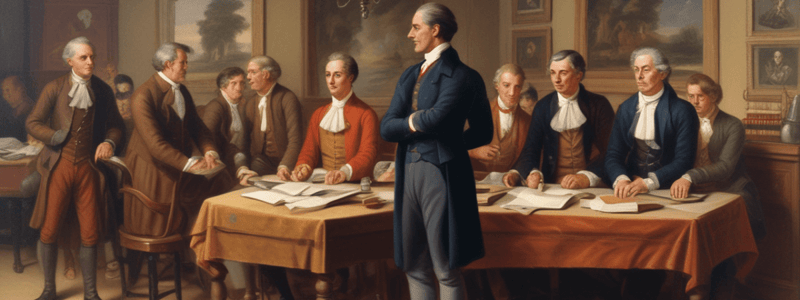Podcast
Questions and Answers
What did the Payne-Aldrich Act of 1909 establish between the Philippines and the United States?
What did the Payne-Aldrich Act of 1909 establish between the Philippines and the United States?
- A system of high Philippine tariffs on American goods
- An embargo on American products entering the Philippines
- A ban on all American products in the Philippines
- A system of free trade (correct)
What were the manifestations of the alleged prosperity during the pistaym era according to the text?
What were the manifestations of the alleged prosperity during the pistaym era according to the text?
- Lower-priced goods, roads, bridges, schools, and government buildings (correct)
- High-priced goods, poor infrastructure, lack of schools, and deteriorating government buildings
- Inaccessible goods, lack of roads and bridges, absence of schools, and corrupt government buildings
- Higher taxes, crumbling infrastructure, insufficient education, and poor governance
Who was the driving force of the Philippine economy during the pistaym era?
Who was the driving force of the Philippine economy during the pistaym era?
- Chinese merchants
- European investors
- Local Filipino entrepreneurs
- American capital (correct)
In which sectors were the Americans overtaken by other foreigners in the Philippines during the pistaym era?
In which sectors were the Americans overtaken by other foreigners in the Philippines during the pistaym era?
What percentage of business volume was transacted by foreigners during the pistaym era?
What percentage of business volume was transacted by foreigners during the pistaym era?
What does the author imply is a significant barrier to solving economic difficulties?
What does the author imply is a significant barrier to solving economic difficulties?
What is the main cause of agitation mentioned?
What is the main cause of agitation mentioned?
In what speech did Senate President Manuel Quezon express these sentiments?
In what speech did Senate President Manuel Quezon express these sentiments?
Which government position was Manuel Quezon nominated for in the speech mentioned in the text?
Which government position was Manuel Quezon nominated for in the speech mentioned in the text?
Which of the following crops was the number one employer of laborers in Manila?
Which of the following crops was the number one employer of laborers in Manila?
Which of the following statements is true about the medical treatment received by Filipino workers, according to the text?
Which of the following statements is true about the medical treatment received by Filipino workers, according to the text?
Which of the following diseases was not mentioned in the text as a cause of death among rural Filipinos?
Which of the following diseases was not mentioned in the text as a cause of death among rural Filipinos?
What percentage of Filipinos in 1935 were affected by tuberculosis?
What percentage of Filipinos in 1935 were affected by tuberculosis?
Based on the information in the text, which of the following statements is true about public education in the Philippines?
Based on the information in the text, which of the following statements is true about public education in the Philippines?
What was the focus of Luis Dery's work 'The Myth of 'Pistaym' Prosperity'?
What was the focus of Luis Dery's work 'The Myth of 'Pistaym' Prosperity'?
What type of sources did Luis Dery rely on for his work 'The Myth of 'Pistaym' Prosperity'?
What type of sources did Luis Dery rely on for his work 'The Myth of 'Pistaym' Prosperity'?
Based on the images provided, what can be inferred about the economic conditions in Manila during the American colonial period?
Based on the images provided, what can be inferred about the economic conditions in Manila during the American colonial period?
What was the purpose of Maria Luisa Camagay's work 'Salud Algabre: A Forgotten Member of the Philippine Sakdal'?
What was the purpose of Maria Luisa Camagay's work 'Salud Algabre: A Forgotten Member of the Philippine Sakdal'?
What can be inferred about Luis Dery's role and expertise based on the information provided?
What can be inferred about Luis Dery's role and expertise based on the information provided?
Based on the information provided, what can be inferred about the nature of the sources used by Maria Luisa Camagay in her work?
Based on the information provided, what can be inferred about the nature of the sources used by Maria Luisa Camagay in her work?
Study Notes
The Myth of 'Pistaym' Prosperity
- The Payne-Aldrich Act of 1909 established a system of free trade between the Philippines and the United States, allowing American products to enter the Philippines without tariffs.
- During the American colonial period, American capital was the driving force of the Philippine economy, with foreigners controlling approximately 70% of the business volume.
- The Filipino economy was reduced to mere cultivators of farmlands, producing export crops such as sugar, coconut, tobacco, and abaca.
The Pre-War Export Crop Economy
- Sugar accounted for 60% of the country's exports and supported 2,000,000 Filipinos directly or indirectly.
- Coconut accounted for 30% of exports and supported 4,000,000 Filipinos.
- Tobacco was the number one employer of laborers in Manila, supporting 600,000 Filipinos.
- Abaca represented 12% of exports and supported 2,506,000 Filipinos.
- Rice supported the livelihood of 4,000,000 Filipinos.
- 13 million out of 16 million Filipinos were dependent on just 5 crops for their livelihood.
Prosperity for Whom?
- Only 172,605 out of 8 million workers received medical-industrial treatment laws.
- Filipino workers were exploited, with sugar workers in Negros receiving less than one centavo per day per individual worker.
- Rural Filipinos faced poor health conditions, with a diet composed of 85-90% carbohydrates and medical needs neglected by employers.
- Common diseases included beriberi, hookworm, and tuberculosis, with 1 million out of 14.7 million Filipinos affected by tuberculosis in 1935.
Education in the American Colonial Period
- Only 60% of 16 million Filipinos finished the elementary grades.
- Out of every 100 students starting in Grade I, 45 reached Grade IV, 14 reached Grade VI, 6 reached first year high school, and 3 reached fourth year high school.
- One out of every three high school graduates went to college.
Studying That Suits You
Use AI to generate personalized quizzes and flashcards to suit your learning preferences.
Related Documents
Description
Test your knowledge on the key discussion points related to the American Colonial Period and the Commonwealth Republic. Topics include education, politics, and socio-economics during the American Colonial Period, as well as insights into the Commonwealth Republic.




